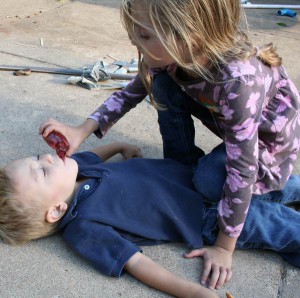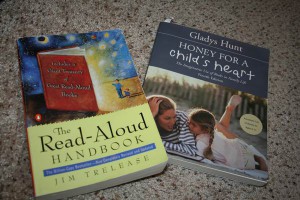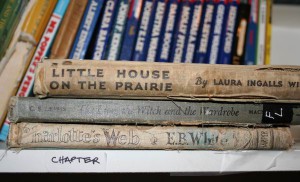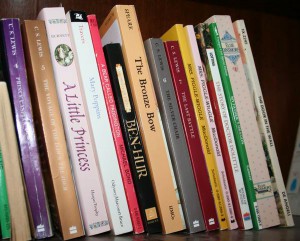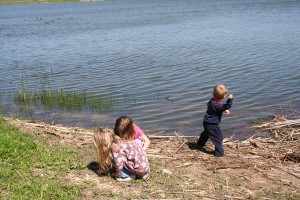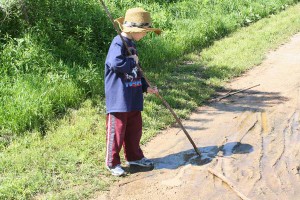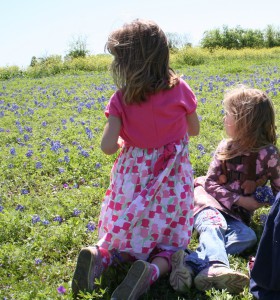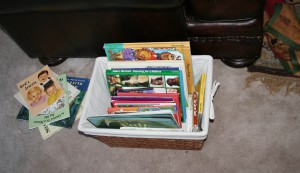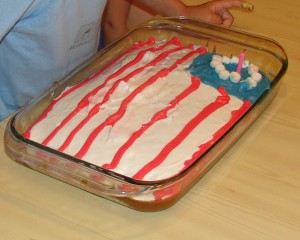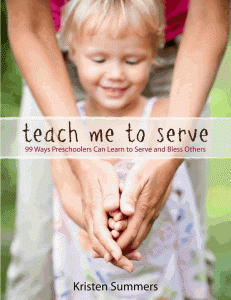 A while back Kristen Summers asked if she could use a snippet of something I wrote in an upcoming eBook. I said sure, then promptly forgot about it.
A while back Kristen Summers asked if she could use a snippet of something I wrote in an upcoming eBook. I said sure, then promptly forgot about it.
Well, imagine my surprise when last week she emailed me and let me know the
eBook was ready! She sent me a free copy for review. I have to tell you, I loved it.
The book is Teach Me to Serve: 99 ways Preschoolers Can Learn to Serve and Bless Others.
In a culture that teaches kids that the world revolves around them (or should), this book is a breath of fresh air with practical, simple ideas for helping our littlest ones grow their hearts to serve others.
I appreciate Kristen’s honest tone. It’s not one of those irritating, “I’m perfect and if you do these things you can be too!” type of books. She is very real in her writing. I like that.
It’s also a fast read, well laid-out, and bulleted, which is nice for a quick skim or going back to look at ideas. Chapter 1 gives the Biblical basis for serving, while Chapter 2 looks at our own example, which is always the key, isn’t it?
Since your kids will model your example, let’s do a quick heart check: Does your child see you having the heart of a servant? Do they see your kindness, compassion and
care for others as they shadow you? Are you helpful? Are you deliberate? Are
you a cheerful giver? When you see a need, do you act? Your children will be
able to sense your concern for others by the way you act in word and deed, and
also by the way you pray for the needs of others.
The book is divided into areas in which to serve:
- Home– LOVE this, because this is where we live. Why not start here?
- Neighborhood
- Community
- Market
- The House of God
- Trips and Travel
- Going Global
I originally thought 99 ways to serve sounded exhausting (99 more things I should be doing?) but the book didn’t feel that way at all. It felt quite manageable and practical.
You can tell the book is written by an experienced mom of preschoolers. The ideas aren’t those that make you tired just thinking about them. She gives small, simple ideas, perfect for little hands and hearts.
For example, I loved the simplicity of:
7. Ask your preschooler to help you (Mommy or Daddy) with one of your chores.
Maybe there is yard work or dusting to be done. Remember, we are not going for
perfection here, just developing a willing heart. Praise your preschooler’s good effort and thank her for being so helpful.
10. When a sibling is sick, allow your preschooler to help take care of his brother
or sister. Give the sick child a bell to ring whenever something is needed. Put your preschooler in charge of finding out what is needed when he hears the bell ring.
20. Your preschooler can help younger siblings by playing the “How Can I Help?”
game. When the younger sibling is frustrated or unable to reach something, have
your preschooler ask, “How can I help?” While a baby will be unable to answer,
your preschooler can pick up the fallen toy or spoon and hand it to her. Making
this a game will help your preschooler become quick to help.
[Love this one. One of my big pet peeves is when adults sit around and talk after a
meal while one person does all the work of a meal or clean-up. I want
to teach my kids look around and see what needs to be done or to ask, “What can
I do to help, Mom?” ]
37. Are you hosting a garage sale? Let your preschooler hand out cups of free
water. Use a dispenser for ease of pouring.
73. When a person drops an item, teach your child to help pick it up.
I have to stop because I’m going to give away the whole book!
There are so many more great ones though.
I love that the author always brings it back to serving others to serve Jesus. There are verses on serving sprinkled throughout.
I happen to think preschoolers don’t need much academic work. My preschool goals for my third son include things like learn to obey, be sweet, play, go outside, and get read to a lot. (If he picks up some letter recognition and number awareness along the way, well, that would be okay too.)
But if a preschooler is doing some of these ideas in the book, they’ll be learning the whole time. They’ll be developing those motor and self-regulation skills, and doing it with a purpose. They’ll be learning the most important things.
I’ll end with the prayer Kristen gives at the end of her book, because it’s so wonderful and it makes me cry:
Lord,
We thank You for the privilege we have of raising our young children. They are a gift and blessing to us and we are grateful. As we embark to teach our children to follow You and raise them in the faith, would You strengthen us to be the parents You intend? Help us to love and train them the way You would. Give us a heart ready to teach and persevere through the easy and rough days of parenting. Guide us in our discipline and consistency. We want to raise godly children.
Father, mold the young hearts of our children into hearts that chase after You and not the things of this world. Cause them to hunger for You even at their young age. Give them a heart to serve You and others, to deny selfishness and to be rich in compassion. Help us to take these tasks and the many teachable moments to demonstrate to our children the concept of serving others and following Your example of loving people. Fill us with Your love. May our minds and hearts grow in the things of God.
In Jesus’ Mighty Name,
Amen.
Disclosure: Kristen provided me a free sample of the eBook in exchange for my honest
opinion. I do not make any profit from sales of the book.
Buy the book here in PDF format. The list price is $3.99 but…
For the next two days (Sept. 25th and 26th, 2012) you can use the
code: homeschool30 for a 30% discount.

